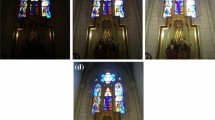Abstract
A new practical method is given for the self-calibration of a camera. In this method, at least three images are taken from the same point in space with different orientations of the camera and calibration is computed from an analysis of point matches between the images. The method requires no knowledge of the orientations of the camera. Calibration is based on the image correspondences only. This method differs fundamentally from previous results by Maybank and Faugeras on self-calibration using the epipolar structure of image pairs. In the method of this paper, there is no epipolar structure since all images are taken from the same point in space, and so Maybank and Faugeras's method does not apply. Since the images are all taken from the same point in space, determination of point matches is considerably easier than for images taken with a moving camera, since problems of occlusion or change of aspect or illumination do not occur.
A non-iterative calibration algorithm is given that works with any number of images. An iterative refinement method that may be used with noisy data is also described. The algorithm is implemented and validated on several sets of synthetic and real image data.
Similar content being viewed by others
References
Atkinson, K.E. 1989. An Introduction to Numerical Analysis, 2nd Edition. John Wiley and Sons: New York.
Basu, A. 1993. Active calibration: Alternative strategy and analysis. In Proc. IEEE Conf. on Computer Vision and Pattern Recognition, pp. 495–500
Beardsley, P.A., Zisserman, A., and Murray, D.W. 1994a. Navigation using affine structure from motion. In Computer Vision–ECCV '94, Volume II, LNCS-Series, Springer-Verlag, Vol. 801, pp. 85–96.
Beardsley, P.A., Zisserman, A., and Murray, D.W. 1994b. Sequential update of projective and affine structure from motion. Report OUEL 2012/94, Oxford University.
Bergen, J.R., Anandan, P., Hanna, K.J., and Hingorani, R. 1992. Hierarchical model-based motion estimation. In Computer Vision– ECCV'92, LNCS-Series, Springer-Verlag, Vol. 588, pp. 237–252.
Dron, L. 1993. Dynamic camera self-calibration from controlled motion sequences. In Proc. IEEE Conf. on Computer Vision and Pattern Recognition, pp. 501–506.
Du, F. and Brady, M. 1993. Self-calibration of the intrinsic parameters of cameras for active vision systems. In Proc. IEEE Conf. on Computer Vision and Pattern Recognition, pp. 477–482.
Faugeras, O.D., Luong, Q.-T., and Maybank, S.J. 1992. Camera self-calibration: Theory and experiments. In Computer Vision–ECCV '92, LNCS-Series, Springer-Verlag, Vol. 588, pp. 321–334.
Hannah, M.J. 1980. Bootstrap stereo. In Proc. Image Understanding Workshop, College Park, MD, pp. 201–208.
Hannah, M.J. 1985. A description of SRI's baseline stereo system. Technical Report Tech. Note 365, SRI International Artificial Intelligence Center.
Hartley, R.I., 1994. Euclidean reconstruction from uncalibrated views. In Applications of Invariance in Computer Vision–LNCS-Series, Springer Verlag, Vol. 825, pp. 237–256.
Horn, B.K.P. 1990. Relative orientation. International Journal of Computer Vision, 4:59–78.
Horn, B.K.P. 1991. Relative orientation revisited. Journal of the Optical Society of America, A, 8(10):1630–1638.
Kruppa, E. 1913. Zur Ermittlung eines Objektes aus zwei Perspektiven mit innerer Orientierung. Sitz.-Ber. Akad.Wiss., Wien, Math. Naturw. Abt. IIa., 122:1939–1948.
Luong, Q.-T. 1992. MatriceFondamentale et CalibrationVisuelle sur l'Environnement. Ph.D. Thesis, Universite de Paris-Sud, Centre D'Orsay.
Maybank, S.J. and Faugeras, O.D. 1992. A theory of self-calibration of a moving camera. International Journal of Computer Vision, 8(2):123–151.
Press, W.H., Flannery, B.P., Teukolsky, S.A., and Vetterling, W.T. 1988. Numerical Recipes in C: The Art of Scientific Computing, Cambridge University Press.
Slama, C.C. (Ed.) 1980. Manual of Photogrammetry. Fourth Edition. American Society of Photogrammetry: Falls Church, VA.
Viéville, T., Luong, Q.T., and Faugeras, O.D. 1995. Motion of points and lines in the uncalibrated case. International Journal of Computer Vision, 17(1):7–41, Jan. 1996.
Author information
Authors and Affiliations
Rights and permissions
About this article
Cite this article
Hartley, R.I. Self-Calibration of Stationary Cameras. International Journal of Computer Vision 22, 5–23 (1997). https://doi.org/10.1023/A:1007957826135
Issue Date:
DOI: https://doi.org/10.1023/A:1007957826135




